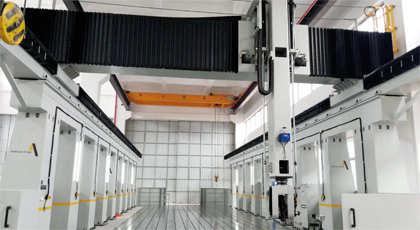In the field of luxury yacht manufacturing, fiber-reinforced plastic (FRP) has always dominated the hull materials with its advantages of light weight, corrosion resistance and free-form shape. However, the performance of FRP products is directly related to the precision of process control, and the slightest deviation in any link may lead to fatal defects such as inter-layer peeling and uneven resin distribution. In this paper, we will analyze the core process control points in yacht FRP manufacturing and reveal how to create zero-defect hull structures through precise process management.
First, the material system design and pretreatment specifications
Fiber selection standards: the main structure of the hull is recommended to use more than 4800tex high modulus glass fiber, deck and other secondary structures can be used in the carbon and glass hybrid fiber. Fiber moisture content should be controlled below 0.08%, and should be dried in 65℃ oven for 4 hours before use.
Optimization of resin ratio: the styrene content of vinyl ester resin should be maintained at 38%-42%, and the thixotropic index should be controlled in the range of 4.5-5.2. When methyl ethyl ketone peroxide (MEKP) is selected as the curing agent, the additive amount should be 1.2%-1.5% of the total amount of resin, and the additive proportion should be reduced by 0.1% for every 5℃ rise in ambient temperature.
Second, mold preparation and release system optimization
yacht mold surface roughness Ra value needs to be ≤ 0.8μm, corner parts need to be chamfered R20mm or more. The use of nano-modified mold release agent, should be implemented "three coats and two baking" process: the first layer of silicone base film cured at 60 ℃ for 30 minutes, the second layer of polyvinyl alcohol isolation film cured at 45 ℃ for 20 minutes, and finally sprayed with PTFE particles of the functional layer. This process can reduce the mold release force to 1/3 of the traditional method, effectively avoiding the phenomenon of "orange peel" on the surface of the product.
Third, the precise control of the lamination process
Layer design: the bottom of the ship and other load-bearing areas using [0 ° / 45 ° / 90 ° / -45 °] four-way staggered pavement, a single layer of fiber density deviation needs to be ≤ 5%. In the keel area, 6-8 layers of UD unidirectional cloth should be added, and the deviation of fiber direction from the main stress axis should not exceed 3°.
Vacuum introduction process: resin runner design to ensure that the front flow rate and the end of the pressure difference ≤ 0.03MPa, infusion network aperture and fiber layer permeability matching factor should be greater than 0.7. Large hulls should be synchronized with the use of multiple injection ports filling, control the overall infiltration time in the range of 45-60 minutes.
Fourth, the thermodynamic management of the curing process
using a stepped curing curve: the first stage of 40 ℃ pre-curing 2 hours to make the resin viscosity down to 500mPa-s; the second stage of the rate of 1.5 ℃ / min temperature rise to 80 ℃, holding time of 4 hours to complete the cross-linking reaction; and finally in the 110 ℃ after the curing process for 3 hours, so that the product bacal hardness reaches 45 or more. Special attention needs to be paid to the mold and product CTE matching, aluminum alloy molds need to be equipped with temperature compensation system to control the thermal expansion differential value of 5 × 10 ^ - 6 / ℃ or less.
V. Quality Inspection and Defect Repair
Ultrasonic Inspection: A 10MHz probe is used to scan the whole area of the hull, and no bubbles with a diameter of >3mm are allowed in the A-level area (below the waterline), and ≤5 defects of less than 2mm/m² are allowed in the B-level area.
Microcrack repair: For the detected delamination defects, hollow needle injection of nano-silica modified resin, under 0.3MPa pressure holding pressure repair, after repairing the shear strength can reach more than 92% of the original structure.
Sixth, the trend of innovation in environmental protection processes
new water-based release system has been achieved to reduce VOC emissions to 12g/m², bio-based epoxy resin carbon footprint compared to traditional products by 43%. A German shipyard using recycled carbon fiber reinforced PET recycled resin, so that the hull material recycling rate of 78%, while maintaining the technical indicators of flexural modulus of 18GPa.
In the Monte Carlo yacht manufacturing base in Italy, through the implementation of the above process control system, the hull of the 55-meter superyacht has been successfully reduced by 12%, structural rigidity increased by 25%, and production costs reduced by 18%. These data confirm that only the deep integration of material science, process engineering and quality control can break through the quality bottleneck of FRP yacht manufacturing. In the future, with the application of digital twin technology in resin flow simulation and the real-time monitoring of lay-up defects by AI vision system, FRP yacht manufacturing will enter a new era of whole-process intelligence.























